Is it possible to eat buckwheat if you have type 2 diabetes?
In type 2 diabetes, when the interaction of insulin with cells is disrupted, a strict diet is prescribed. The basis of nutrition consists of vegetables, cereals, and low-fat protein dishes. Avoid foods with a glycemic index above 50–55: sweets, sweet fruits, dishes made from refined flour. Let's consider whether it is possible or not to eat buckwheat if you have type 2 diabetes.
Chemical composition of buckwheat
Cereals are made from buckwheat seeds.
They produce 3 varieties of buckwheat:
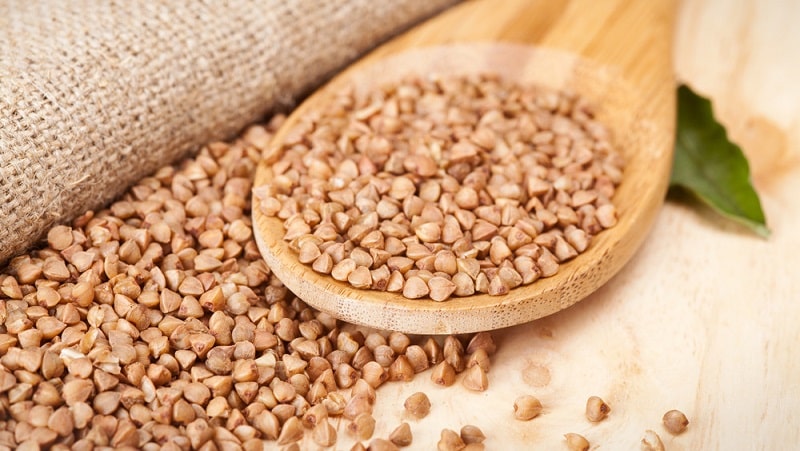
The basis of the product is complex carbohydrates and dietary fiber. The calorie content of buckwheat is 335 kcal per 100 g.
Nutritional value of 100 g of raw kernels:
- carbohydrates - 54.3 g;
- vegetable proteins - 12.6 g;
- fats - 3.3 g;
- water - 14 g;
- fiber - 11.3 g.
The properties of buckwheat porridges and side dishes depend on types of cereals and cooking methods.
Composition 100 g crumbly and viscous kernel porridge respectively:
- complex carbohydrates - 29.9 and 15.8 g;
- simple carbohydrates - 0.6 and 1.3 g;
- proteins - 5.9 and 3.2 g;
- fats - 1.6 and 0.3 g;
- calorie content - 163 and 90 kcal.
Glycemic index kernel porridge is 40 units. The glucose index is taken as 100 units, which is absorbed quickly and completely.
Buckwheat does not lower blood sugar levels. 40% of carbohydrates are absorbed from it, which are gradually processed and supply the blood with glucose.The consumption of complex carbohydrates, including cereals, is limited in case of type 2 diabetes, since in large quantities they increase sugar levels.
Vitamins and beneficial properties
Buckwheat cereal is rich in vitamins groups B (up to 25% of the daily value), E (32%), PP (20%). Contains minerals: potassium, phosphorus, magnesium, silicon, copper, iron, boron, manganese.
Fiber (56% per 100 g) reduces the rate of glucose absorption in the intestines, so its level in the blood increases and decreases gradually.
Is it possible to eat buckwheat if you have type 2 diabetes?
For proper nutrition, diabetics are advised to include porridge and side dishes made from whole grains in their menu every day. It is better to alternate buckwheat, oatmeal, pearl barley, millet porridge.
Important! The diet must be balanced, so the kefir-buckwheat diet is prohibited for weight loss.
Excessive consumption of buckwheat porridge, like other complex carbohydrates, blood glucose levels exceed the norm.
In recommended quantities, buckwheat is beneficial:
- saturates for a long time;
- supplies the body with dietary fiber, minerals, vitamins;
- gently cleanses the intestines.
How to use correctly and often
Diabetics are advised to cook porridge from whole grains, since when food is chopped, the glycemic index increases.
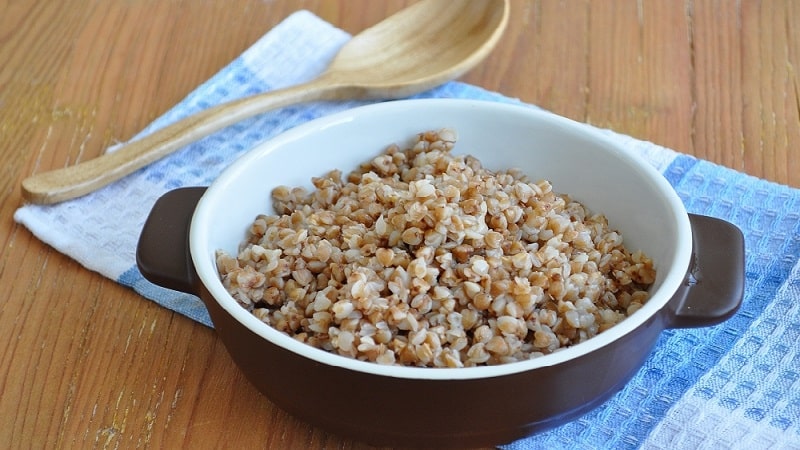
How to choose buckwheat
Core evaluation at the time of buying:
- A modern method of heat treatment of grains is steaming. These grains are light brown in color; when roasted, they are dark brown.
- Beans that have not undergone heat treatment have a green color. This buckwheat retains more nutrients than brown buckwheat. Contains rutin, which strengthens blood vessels.
- The grains are the same size, there are no foreign impurities.
- High-quality cereal is dry, without the smell of mold.
Do not cook with grains that are bitter or sour taste.
Which one is better to eat?
Porridges made from prodel, Smolensk groats, and buckwheat flakes are not recommended for diabetics due to the high glycemic index. Most healthy green buckwheat dishes, in 2nd place - porridge made from steamed kernels.
Disadvantages of green cereals:
- high price;
- short shelf life (no more than 2 months after opening the package);
- unusual taste, which improves when heated in a frying pan.
How to store
The storage conditions for cereals in original packaging indicate them directly. After opening the package, buckwheat is poured into containers made of glass, metal, ceramics and closed with a lid.. Place paper or fabric bags with salt inside. The jars are kept in a dry, dark place for 2 to 4 months.
Attention! Cereals cannot be used if there is a musty smell, lumps, or insects.
To protect the product from pests, it is washed and calcined in the oven before storage.
In what form to use
Buckwheat is eaten as a separate dish or side dish. It is better for diabetics to cook cereals in water:
- The crumbly porridge is made in a slow cooker or saucepan for about 20 minutes. The ratio of cereal and water is 1:2.
- The viscous porridge is cooked for up to 1 hour. Add 4 times more water than for crumbly.
- The kernel is poured with boiling water and infused in a thermos or tightly closed container.
Recommendations of naturopathic doctors for preserving the nutritional value of the kernel:
- roast the cereal;
- soak before cooking in cold water in a ratio of 1:2.5 for 3 hours;
- After soaking, cook for a few minutes over low heat.
Consumption rate
For people with type 2 diabetes, doctors give individual recommendations on the consumption of complex carbohydrates. Starchy foods are distributed evenly throughout the day.On average, the volume of finished buckwheat is up to 1 tbsp. per day, provided that there are no other dishes from cereals, pasta, potatoes.
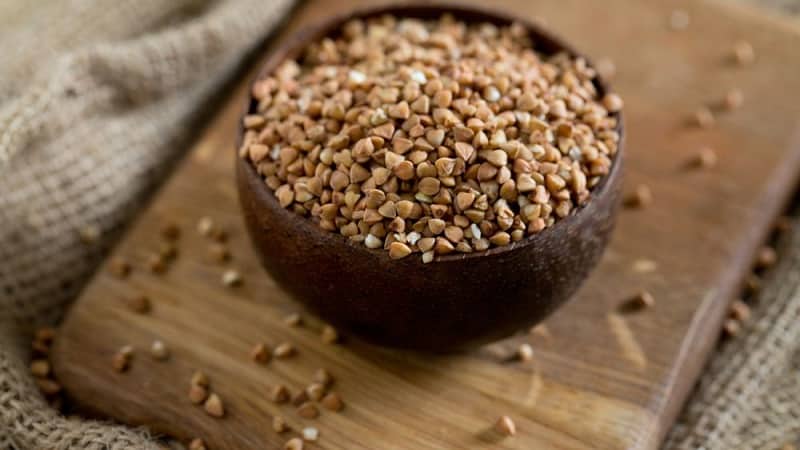
What to eat with
Add vegetable oil and cod liver to the dish. The overall glycemic index decreases if you consume raw vegetables (cucumbers, tomatoes) and herbs at the same time as porridge.
Combine with buckwheat:
- nuts;
- eggs;
- mushrooms;
- poultry and meat dishes;
- dairy products.
Porridge with cottage cheese or kefir eat for breakfast or dinner. With such combinations, the body receives the necessary nutrients, and the food becomes more satisfying.
Recipes
Let's give 3 simple recipes for whole buckwheat dishes for type 2 diabetics.
Vegetable salad with buckwheat
Ingredients:
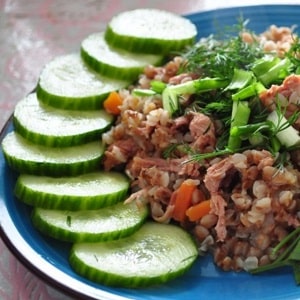 1 tbsp. crumbly porridge;
1 tbsp. crumbly porridge;- medium sized cucumber;
- 150 g each of cabbage and daikon;
- dill and parsley;
- 1 tsp. olive oil;
- salt and pepper - to taste.
Preparation:
- The cabbage is chopped and mashed.
- Cucumber and daikon are cut into cubes.
- Chop greens.
- Vegetables and buckwheat are mixed in a salad bowl with high sides.
- Salt, pepper, season with olive oil.
The glycemic index of salad is lower than porridge. The dish is suitable for lunch or dinner.
Important! Vegetable dishes with cereals are not stored, but consumed immediately.
Stuffed cabbage rolls with buckwheat
Ingredients:
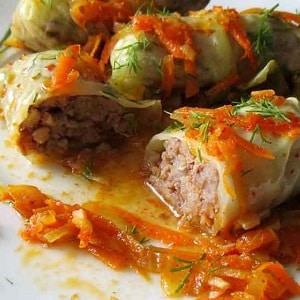 1 medium fork white cabbage;
1 medium fork white cabbage;- 1.5 tbsp. crumbly buckwheat porridge;
- 2 medium onions;
- 2 tbsp. l. vegetable oil;
- 0.5 tbsp. low-fat sour cream;
- 2 tbsp. l. crackers;
- greens - to taste.
Preparation:
- The cabbage stalk is cut out.
- Place the head of cabbage in a saucepan, pour boiling water over it, and blanch for 5 minutes. Then cool.
- 9-10 upper leaves are separated. Cut and beat off the stems.
- Peel the onion, chop finely, sauté in 1 tbsp. l. vegetable oil.
- Mix buckwheat with onions.
- Place 1 tbsp on each sheet. l. fillings.
- The cabbage rolls are wrapped in envelopes and tied with thread.
- Place on a baking sheet greased with vegetable oil.
- Lubricate with sour cream, sprinkle with breadcrumbs.
- The cabbage rolls are browned in the oven.
Serve the dish with fresh herbs.
Mushroom soup
The norm for mushrooms for type 2 diabetes is 100 g per week.
To prepare 2 servings you will need:
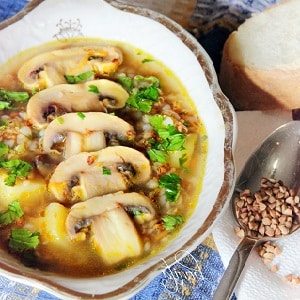 150 g fresh mushrooms;
150 g fresh mushrooms;- 3 tbsp. l. kernels;
- 4 tbsp. water;
- 2 tsp. vegetable oil;
- greens and salt - to taste.
Preparation:
- Mushrooms are cleaned and washed. Place in a colander and allow the water to drain. Then they cut it.
- Boil water in a saucepan and add mushrooms.
- After boiling, remove the foam and salt.
- Boil the mushrooms until tender.
- Add washed buckwheat. Bring to readiness over low heat.
Add butter and chopped herbs to the bowl of soup.
Conclusion
For type 2 diabetes, properly selected and prepared buckwheat is beneficial. It supplies the body with energy, vegetable proteins, dietary fiber, vitamins and minerals.
With the amount of carbohydrates recommended by doctors per day, porridge does not increase blood glucose. The glycemic index decreases if you eat cereals along with vegetables and herbs.